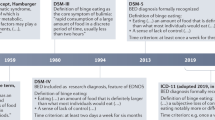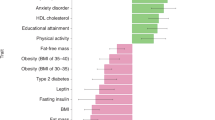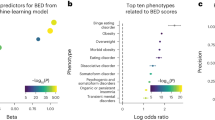Abstract
Recently, Branson and coworkers reported a strong association between binge-eating disorder (BED) and variants in the melanocortin-4 receptor gene (MC4R). In the current study, we compared the eating behavior of 43 obese probands with functionally relevant MC4R mutations and of 35 polymorphism carriers (V103I or I251L) with wild-type carriers. The module for eating disorders of the Composite International Diagnostic Interview was used to identify binge-eating behavior. The Three-Factor Eating Questionnaire and the Leeds Food Frequency Questionnaire were used to assess restrained eating, disinhibition, hunger and percent total energy intake as fat. No significant differences between carriers of MC4R variants and wild-type carriers were detected. In particular, we found no evidence for an increased rate of binge-eating behavior in obese carriers of MC4R variants. Our findings do not support the strong association between BED and MC4R carrier status.
This is a preview of subscription content, access via your institution
Access options
Subscribe to this journal
Receive 12 print issues and online access
$259.00 per year
only $21.58 per issue
Buy this article
- Purchase on Springer Link
- Instant access to full article PDF
Prices may be subject to local taxes which are calculated during checkout
Similar content being viewed by others
References
Marks DL, Butler AA, Cone RD . Melanocortin pathway: animal models of obesity disease. Ann Endocrinol 2002; 63(Part 1): 121–124.
Tritos NA, Maratos-Flier E . Two important systems in energy homeostasis: melanocortins melanin-concentrating hormone. Neuropeptides 1999; 33: 339–349.
Hinney A, Hohmann S, Geller F, Vogel C, Hess C, Wermter AK et al. Melanocortin-4 receptor gene: case–control study and transmission disequilibrium test confirm that functionally relevant mutations are compatible with a major gene effect for extreme obesity. J Clin Endocrinol Metab 2003; 88: 258–267.
Harrold JA, Widdowson PS, Williams G . Beta-MSH: a functional ligand that regulated energy homeostasis via hypothalamic? Peptides 2003; 24: 397–405.
Adan RA, Kas MJ 2003 Inverse agonism gains weight. Trends Pharmacol Sci 24: 315–321.
Yang Y, Chen M, Lai Y, Gantz I, Yagmurlu A, Georgeson KE et al. Molecular determination of agouti-related protein binding to human receptor. Mol Pharmacol 2003; 64: 94–103.
Huszar D, Lynch CA, Fairchild-Huntress V, Dunmore JH, Fang Q, Berkemeier LR et al. Targeted disruption of the melanocortin-4 receptor results in obesity in mice. Cell 1997; 88: 131–141.
Ste Marie L, Miura GI, Marsh DJ, Yagaloff K, Palmiter RD . A metabolic defect promotes obesity in mice lacking receptors. Proc Natl Acad Sci USA 2000; 97: 12339–12344.
Chen AS, Metzger JM, Trumbauer ME, Guan XM, Yu H, Frazier EG et al. Role of the melanocortin-4 receptor in metabolic rate and food intake in mice. Transgenic Res 2000; 9: 145–154.
Yeo GS, Farooqi IS, Aminian S, Halsall DJ, Stanhope RG, O'Rahilly S . A frameshift mutation in MC4R associated with dominantly inherited human obesity. Nat Genet 1998; 20: 111–112.
Vaisse C, Clément K, Guy-Grand B, Froguel P . A frameshift mutation in human MC4R is associated with a dominant form of obesity. Nat Genet 1998; 20: 113–114.
Hinney A, Schmidt A, Nottebom K, Heibült O, Becker I, Ziegler A et al. Several mutations in the melanocortin-4 receptor gene including a nonsense and a frameshift mutation associated with dominantly inherited obesity in humans. J Clin Endocrinol Metab 1999; 84: 1483–1486.
Nijenhuis WA, Garner KM, van Rozen RJ, Adan RA . Poor cell surface expression of human melanocortin-4 receptor mutations associated with obesity. J Biol Chem 2003; 278: 22939–22945.
Yeo GS, Lank EJ, Farooqi IS, Keogh J, Challis BG, O'Rahilly S . Mutations in the human melanocortin-4 receptor gene associated with severe familial obesity disrupts receptor function through multiple molecular mechanisms. Hum Mol Genet 2003; 12: 561–574.
Lubrano-Berthelier C, Durand E, Dubern B, Shapiro A, Dazin P, Weill J et al. Intracellular retention is a common characteristic of childhood obesity-associated MC4R mutations. Hum Mol Genet 2003; 12: 145–153.
Vaisse C, Clement K, Durand E, Hercberg S, Guy-Grand B, Froguel P . Melanocortin-4 receptor mutations are a frequent and heterogeneous cause of morbid obesity. J Clin Invest 2000; 106: 253–262.
Farooqi IS, Keogh JM, Yeo GS, Lank EJ, Cheetham T, O'Rahilly S . Clinical spectrum of obesity and mutations in the melanocortin 4 receptor gene. N Engl J Med 2003; 348: 1085–1095.
Sina M, Hinney A, Ziegler A, Neupert T, Mayer H, Siegfried W et al. Phenotypes in three pedigrees with autosomal dominant obesity caused by haploinsufficiency mutations in the melanocortin-4 receptor gene. Am J Hum Genet 1999; 65: 1501–1507.
Farooqi IS, Yeo GS, Keogh JM, Aminian S, Jebb SA, Butler G et al. Dominant and recessive inheritance of morbid obesity associated with melanocortin 4 receptor deficiency. J Clin Invest 2000; 106: 271–279.
Branson R, Potoczna N, Kral JG, Lentes K-U, Hoehe MR, Horber FF . Binge eating as a major phenotype of melanocortin 4 receptor gene mutations. N Engl J Med 2003; 348:1096–1103.
Hebebrand J, Fichter M, Gerber G, Gorg T, Hermann H, Geller F et al. Genetic predisposition to obesity in bulimia nervosa: a mutation screen of the melanocortin-4 receptor gene. Mol Psychiatry 2002; 7: 647–651.
Wittchen HU, Beloch E, Garczynski E, Holly A, Lachner G, Perkonigg A et al. Münchener Composite International Diagnostic Interview (M-CIDI, Paper–pencil and CAPI version 2.2, 2/95, English). Max-Planck-Institute of Psychiatry, Clinical Institute: Munich, 1995.
Diagnostic and Statistical Manual of Mental Disorders, Revised 3rd edn. (DSM-III-R). American Psychiatric Association Press: Washington, DC, 1987.
Diagnostic and Statistical Manual of Mental Disorders, 4th edn. (DSM-IV). American Psychiatric Association Press: Washington, DC, 1994.
Stunkard AJ, Messick S . The three-factor eating questionnaire to measure dietary restraint, disinhibition and hunger. J Psychosom Res 1985; 29: 71–83.
Pudel V, Westenhöfer J . Fragebogen zum Eβverhalten: Handanweisung. Hogrefe: Göttingen, 1989.
Cooling J, Blundell J . Differences in energy expenditure and substrate oxidation between habitual high fat and low fat consumers (phenotypes). Int J Obes Relat Metab Disord 1998; 22: 612–618.
Abecasis GR, Cardon LR, Cookson WO . A general test of association for quantitative traits in nuclear families. Am J Hum Genet 2000; 66: 279–292.
Ho G, MacKenzie RG . Functional characterization of mutations in melanocortin-4 receptor associated with human obesity. J Biol Chem 1999; 274: 35816–35822.
Gu W, Tu Z, Kleyn PW, Kissebah A, Duprat L, Lee J et al. Identification and functional analysis of novel human melanocortin-4 receptor variants. Diabetes 1999; 48: 635–639.
Devlin MJ, Goldfein JA, Dobrow I . What is this thing called BED? Current status of binge eating disorder nosology. Int J Eat Disord 2003; 34(Suppl 1): S2–S18.
Lee YH, Abbott DW, Seim H, Crosby RD, Monson N, Burgard M et al. Eating disorders and psychiatric disorders in the first-degree relatives of obese probands with binge eating disorder and obese non-binge eating disorder controls. Int J Eat Disord 1999; 26: 322–332.
Herpertz S, Siffert W, Hebebrand J . Binge eating as a phenotype of melanocortin 4 receptor gene mutations. N Engl J Med 2003; 349: 606–609.
Acknowledgements
The participation of the probands and their families is gratefully acknowledged. This study was supported by the Bundesministerium für Bildung und Forschung (Nationales Genomforschungsnetz 01GS0118) and the European Union (Framework V ‘Diet and obesity’ QK-CT-2000–00515).
Author information
Authors and Affiliations
Corresponding author
Rights and permissions
About this article
Cite this article
Hebebrand, J., Geller, F., Dempfle, A. et al. Binge-eating episodes are not characteristic of carriers of melanocortin-4 receptor gene mutations. Mol Psychiatry 9, 796–800 (2004). https://doi.org/10.1038/sj.mp.4001491
Received:
Revised:
Accepted:
Published:
Issue Date:
DOI: https://doi.org/10.1038/sj.mp.4001491
Keywords
This article is cited by
-
A review on association and correlation of genetic variants with eating disorders and obesity
Future Journal of Pharmaceutical Sciences (2021)
-
A review of binge eating disorder and obesity
neuropsychiatrie (2021)
-
Relevance of polymorphisms in MC4R and BDNF in short normal stature
BMC Pediatrics (2018)
-
Monogene Adipositas
Medizinische Genetik (2017)
-
Association between melanocortin-4 receptor mutations and eating behaviors in obese patients: a case–control study
International Journal of Obesity (2014)



